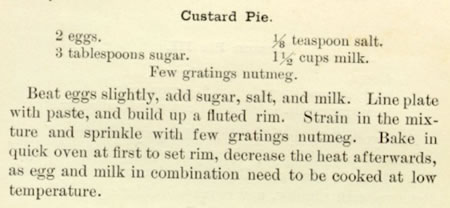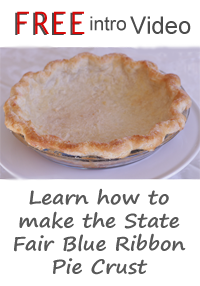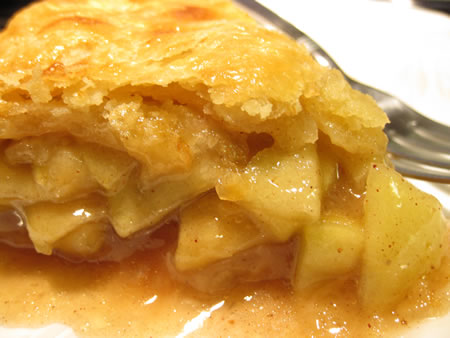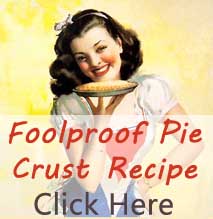Custard Pie Recipe – Vintage – 1896
Posted by Warren
Makes one 9-inch pie, single crust, custard filling
The Boston Cooking-School Cookbook, by Fannie Merritt Farmer, 1896

This custard pie recipe has some detailed baking instructions that set it apart from the rest. Notice the pie is put in very hot oven to set the crust and then turned down to complete the baking. And you thought it was just discovered.
Custard Pie Recipe
The Boston Cooking-School Cookbook, by Fannie Merritt Farmer, 1896
Custard Pie.
2 eggs.
3 tablespoons sugar.
1/8 teaspoon salt.
1 1/2 cups milk.
Few gratings nutmeg.
Beat eggs slightly, add sugar, salt, and milk. Line plate with paste, and build up a fluted rim. Strain in the mixture and sprinkle with few gratings nutmeg. Bake in quick oven at first to set rim, decrease the heat afterwards, as egg and milk in combination need to be cooked at low temperature.
A Cookbook with vintage pie recipes
Fannie Farmer, the author of this cookbook, is perhaps the best known of the great American culinary authorities of the turn of the 19th to 20th centuries. And this book is arguably the best known and most influential of all American cookbooks.
It has been in print from its first appearance in 1896 until the current day, although the newer editions are updated and revised so that Fannie might not easily recognize them. From its first printing it was a bestseller.
The first edition of 3000 sold outquickly. It was reprinted twice in 1897 and once a year thereafter until 1906. It was then revised for the next edition. New and revised editions, in multiple reprints, continue to be published. It was reprinted in England and translated into French, Spanish, Japanese and Braille.
Little, Brown, the publishers, evidently was afraid of losing their money on a cookbook. They required Fannie to pay for the first printing herself. However, Fannie was smart and kept ownership of the copyright on the book. Thus, she became wealthy while Little, Brown regrets this error to the day of death.
Custard Pie Recipe – Old Fashioned of 1896
—Ingredients and instructions are not the actual vintage recipe but is provided for reference purposes.
Pastry dough – single crust
1 1/2 cups unbleached all-purpose flour
2 tablespoons sugar
1/4 teaspoon fine salt
1/2 cup (1 stick) cold unsalted butter
1/4 cup ice cold water
1 teaspoon cold canola oil
Filling
1 1/2 pint milk (scalded)
heaping table-spoonful of sugar
3 large eggs
1/4 teaspoon ground nutmeg
pinch of salt
Directions
1. Prepare the pastry: Roll the pastry and line a 9-inch pie plate with the bottom crust. Roll out the remaining dough for the top crust. Chill the pastry and partial-bake.
2. Heat the milk until a thin skin appears on top of the liquid.
Milk or cream is the most common base for custards. Heavy cream makes a richer and more flavorable custard.
3. Preheat the oven to 350° F.
4. Mix the eggs, sugar, nutmeg and salt in a separate bowl. Do not over beat to the point air gets incorporated into the mixture. This will make your custard grainy.
5. Whisking the egg mixture constantly, slowly add about a third of the hot milk. This will temper the eggs. If this is done too quickly, the eggs will cook, and you will have scrambled eggs in your custard.
6. Now add the rest of the milk whisking slowly
7. Slowly pour the mixture into the cooled partially baked pie shell.
8. Cover edges of pie with foil or use a pie crust shield.
9. Set the pie on the lower center oven rack and bake for 20 minutes, turn the pie 180° degrees. Continue baking until the center is set, about another 20 minutes.
Overcooked custard
will have
a pronounced ???eggy??? flavor.
10. When ready the filling will be firm. The edges of the filling may puff up a little. You should not see much browning.
11. Shake the custard gently to check for doneness. When the custard ripples on the surface that move back and forth like jello it is properly done. You do not want waves of concentric, circular, rings when giving the shake test.
12. Transfer the pie to cool and set in refrigerator to chill.
Custard Pie Success
Better resturants often strain custards before baking them to remove unblended bits of eggs This is a little fussy for a homemade pie. But it does make the custard more refined. If you sould like to do this, strain the custard through a fine mesh sieve into a bowl before pouring it into your pie crust.



